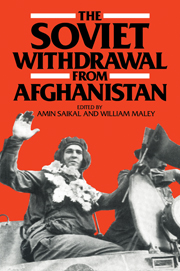Book contents
- Frontmatter
- Contents
- Preface
- 1 Introduction
- 2 The Geneva Accords of April 1988
- 3 Post-Withdrawal Afghanistan: Light at the End of the Tunnel
- 4 The Regional Politics of the Afghan Crisis
- 5 The Afghan Conflict and Soviet Domestic Politics
- 6 The Soviet Armed Forces and the Afghan War
- 7 Afghanistan and Soviet Alliances
- 8 Afghanistan and Sino-Soviet Relations
- 9 The Afghanistan 'Settlement' and the Future of World Politics
- 10 Conclusions: Management of the Afghan Crisis
- List of Contributors
- Index
6 - The Soviet Armed Forces and the Afghan War
Published online by Cambridge University Press: 09 November 2009
- Frontmatter
- Contents
- Preface
- 1 Introduction
- 2 The Geneva Accords of April 1988
- 3 Post-Withdrawal Afghanistan: Light at the End of the Tunnel
- 4 The Regional Politics of the Afghan Crisis
- 5 The Afghan Conflict and Soviet Domestic Politics
- 6 The Soviet Armed Forces and the Afghan War
- 7 Afghanistan and Soviet Alliances
- 8 Afghanistan and Sino-Soviet Relations
- 9 The Afghanistan 'Settlement' and the Future of World Politics
- 10 Conclusions: Management of the Afghan Crisis
- List of Contributors
- Index
Summary
Between the end of the Second World War in 1945 and the beginning of the intervention in Afghanistan in late 1979 the Soviet armed forces saw very little action compared to those of the USA, Britain and France, or even to those of smaller powers such as Israel, Egypt, Syria, Jordan, Iraq, Portugal, Australia and New Zealand outside the Communist world, and Vietnam within it. The use of overwhelming force ensured that in East Germany in 1953 and Hungary in 1956 violent resistance would be quickly suppressed, and that in Czechoslovakia in 1968 it would not be attempted. Abstention from direct involvement in conflicts which they could not be sure of winning, such as Korea and Vietnam, helped the Soviet armed forces to acquire in the eyes of potential adversaries, and perhaps also in their own, a reputation for great capability, based on the one hand upon their undoubted achievements in the Second World War, and on the other upon their sheer size and estimates of the scale and quality of their equipment. So when Soviet forces entered Afghanistan, noncommunist governments initially took their ability to dominate it for granted, and drew far-reaching strategic conclusions about Soviet designs on Gulf oil resources or sea-borne oil traffic. The minority who decried these assessments, and argued that the intervention related solely to the Afghan internal situation, are probably justified by the outcome, because none of the dire prophecies was fulfilled. But there is a sense in which the argument cannot be resolved.
- Type
- Chapter
- Information
- The Soviet Withdrawal from Afghanistan , pp. 82 - 100Publisher: Cambridge University PressPrint publication year: 1989



